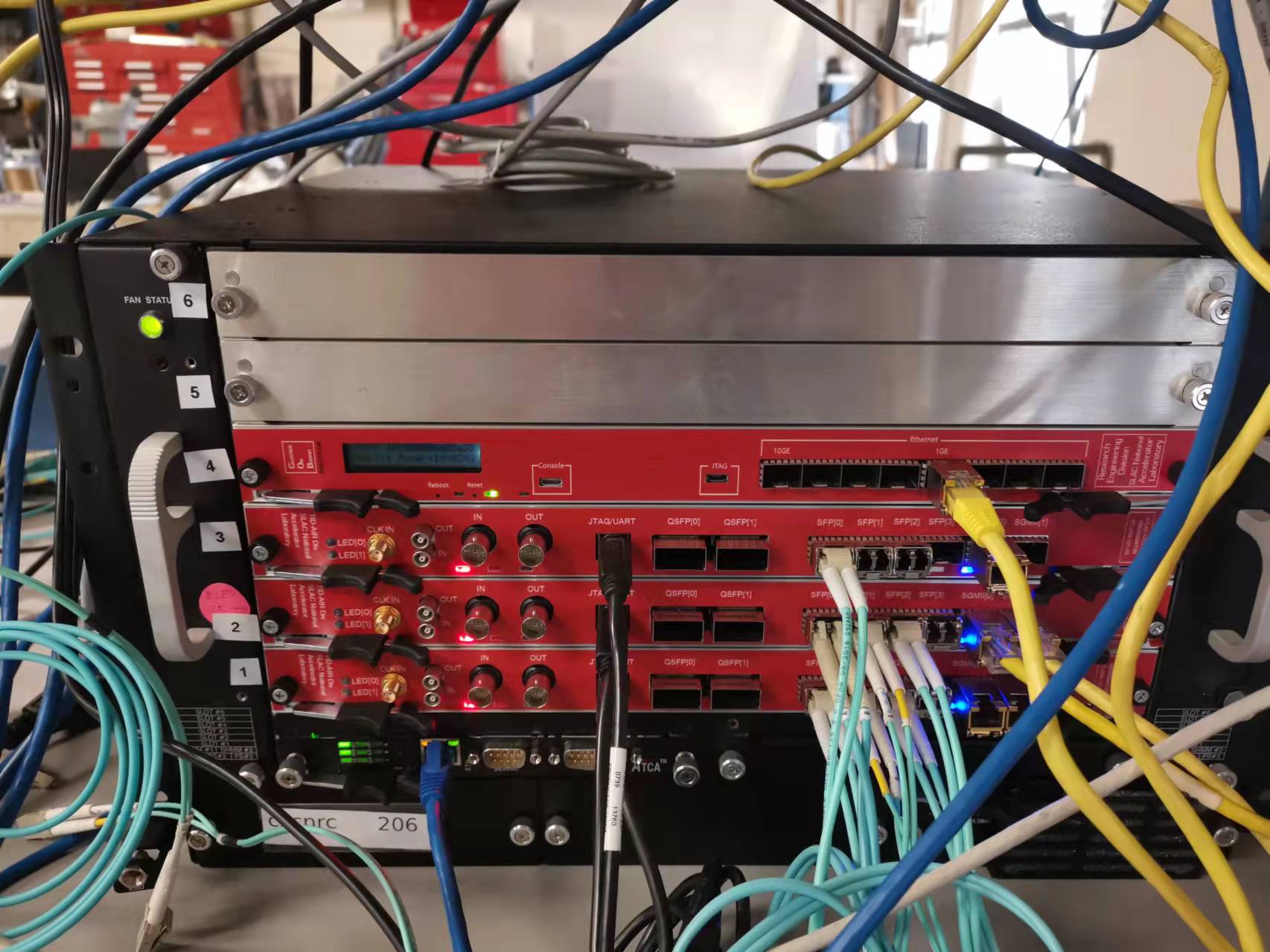Introduction
Front View:
From bottom to top, this ATCA crate has 6 slots in total. The slot 1, 2, 3 have the linkAgg board, while the slot 4 has COB (RCE-Gen3).
For the linkAgg board front panel, there are 4 different interfaces:
1) 2x SFP Ethernet (yellow ethernet cable): used for slow controlling the linkAgg FPGA internal register;
2) 4x High speed SFP+ : optical fiber cable (cyan cable) connected to backend DAQ. Speed depends on the protocol. For example, lpGBT protocol is 10Gbps, Pgpv4 is 6Gbps;
3) 2x High speed QSFP+: 1x QSFP+ port is equivalent to 4x SFP+; all others are same as SFP+ ports;
4) JTAG (USB type A black cable): to program the linkAgg FPGA.
Useful IP Addresses
LinkAgg board
the hardware project page: https://confluence.slac.stanford.edu/display/AIRTRACK/PC_256_101_02_C01
| linkAgg Board # | MAC 4 | IP 1 | MAC 5 | IP 2 | hardware description |
|---|---|---|---|---|---|
C01-01 | 08:00:56:00:4f:82 | 192.168.4.66 | 08:00:56:00:4f:83 | 192.168.4.67 | ATLAS ATCA Link Aggregator Board C01-01 - HWDB 267390223 |
| C01-02 | 08:00:56:00:4f:88 | 192.168.4.72 | 08:00:56:00:4f:89 | 192.168.4.73 | ATLAS ATCA Link Aggregator Board C01-02 - HWDB 267390220 |
| C01-03 | 08:00:56:00:4f:8e | 192.168.4.78 | 08:00:56:00:4f:8f | 192.168.4.79 | ATLAS ATCA Link Aggregator Board C01-03 - HWDB 267390217 |
*Note, the MAC 4 and MAC 5 are for the two front-panel ethernet ports, and MAC0-3 are for the ATCA fabric backplane, which we are not using so far
ATCA crate
| ATCA Name | IP | Location | access |
|---|---|---|---|
| 6-Slot ASIS | 192.168.4.2 | B84, room B231 (lab C) | root/NA |
| 2-Slot ASIS | 192.168.4.210 | B84, room B231 (lab C) | root/NA |
FPGA firmware for the linkAgg board
the firmware is officially released here: https://github.com/slaclab/atlas-rd53-atca-dev/releases
current lpGBT emulator firmware for linkAgg is AtlasAtcaLinkAggRd53Rtm_EmuLpGbt-0x03010000-20220204084052-ruckman-6bfc5ca.bit
current PGPv4 firmware for linkAgg is AtlasAtcaLinkAggRd53Rtm_Pgp4_6Gbps-0x03010000-20220204084122-ruckman-6bfc5ca.bit
*the XXX.bit file can be used to program the FPGA through the JTAG interface with vivado software
*the XXX.mcs file can be programmed to a permanent memory of the linkAgg firmware, so that the FPGA can automatically get firmware from the memory when power on
Vivado to program the FPGA through JTag interface
Software to slow control the linkAgg Firmware
the rogue-based GUI software is also included in the same github project of the firmware: https://github.com/slaclab/atlas-rd53-atca-dev
in order to run this software, need to install rogue package at first: https://slaclab.github.io/rogue/installing/anaconda.html#
Instruction to install the rogue
install anaconda at first:
$ wget https://repo.anaconda.com/archive/Anaconda3-2020.07-Linux-x86_64.sh $ bash Anaconda3-2020.07-Linux-x86_64.sh
Use the following command to add anaconda to your environment. This can be added to your .bash_profile.
$ source /path/to/my/anaconda3/etc/profile.d/conda.sh
install rogue enviroment:
$ conda create -n rogue_5.6.5 -c tidair-packages -c conda-forge -c pydm-tag -c tidair-tag rogue=v5.6.5
(rogue 5.6.5 is verified to work with the GUI software. New version may fail)
Enable the rogue enviroment
$ conda activate rogue_5.6.5
Download the linkAgg github project
$ git clone --recursive git@github.com:slaclab/atlas-rd53-atca-dev
or
$ git clone --recursive https://github.com/slaclab/atlas-rd53-atca-dev.git
Run the software:
$ cd atlas-rd53-atca-dev/software/
$ python3 scripts/gui.py --ip <IP add> --remoteDevice <firmware_type>
the firmware_type is LinkAggLpGBt or LinkAggPgp or Kcu105 or Zcu102. You can find the IP address from here: linkAgg boards IP
For example, python3 scripts/gui.py --ip 192.168.4.72 --remoteDevice LinkAggLpGBt


